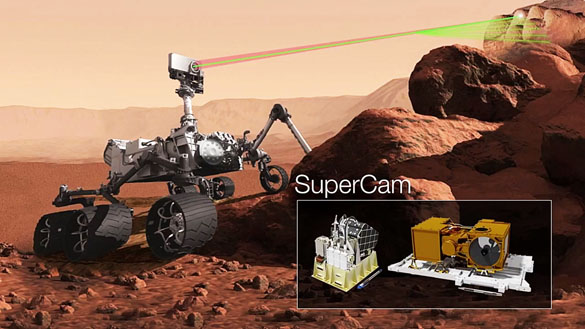 SuperCam builds upon the successful capabilities demonstrated by ChemCam aboard the Curiosity Rover during NASA’s current Mars Mission. SuperCam will allow researchers to sample rocks and other targets from a distance using a laser. In addition to harnessing Los-Alamos developed Laser-Induced Breakdown Spectroscopy (LIBS) technology—which can determine the elemental composition of the target from more than 20 feet away—SuperCam adds another spectrum to its laser for Raman and time-resolved fluorescence spectroscopy. Courtesy/LANL
SuperCam builds upon the successful capabilities demonstrated by ChemCam aboard the Curiosity Rover during NASA’s current Mars Mission. SuperCam will allow researchers to sample rocks and other targets from a distance using a laser. In addition to harnessing Los-Alamos developed Laser-Induced Breakdown Spectroscopy (LIBS) technology—which can determine the elemental composition of the target from more than 20 feet away—SuperCam adds another spectrum to its laser for Raman and time-resolved fluorescence spectroscopy. Courtesy/LANL
LANL News:
- SuperCam’s body to be built at Los Alamos and the mast in France
NASA Administrator Charles Bolden and Jean-Yves Le Gall, president of the French space agency, Centre National d’Etudes Spatiales (CNES), signed an agreement Tuesday at the Paris Air Show for France to provide the mast unit for the SuperCam component of NASA’s Mars 2020 rover.
Los Alamos National Laboratory is coordinating with the French science and engineering team on developing SuperCam, the next-generation version of the ChemCam device currently on Mars as part of the Curiosity rover’s essential equipment.
“SuperCam capitalizes on all we’ve learned with ChemCam’s laser on Curiosity, plus it adds two new analysis techniques, Raman and infrared spectroscopies. Both will provide insights into mineralogy and search for organic materials,” said Roger Wiens, lead scientist on the SuperCam project at Los Alamos.
The SuperCam instrument was selected in August 2014, to be part of the new rover payload. Like ChemCam, it will use a laser to analyze targets within the vicinity of the rover.
“I’m delighted that our long-time partners CNES will join us on the next step in our journey to Mars,” Bolden said, “We’re paving the way for humans to visit the Red Planet and working to answer one of the key questions for all humanity: has there ever been life elsewhere?”
Bolden also signed an agreement that extends cooperation with Spain on the Mars Science Laboratory Curiosity rover, the NASA InSight mission that will launch next year to study the core of Mars, and for the Mars 2020 rover. The latter includes provisions for Spain to provide on-board calibration targets for SuperCam, essentially making this instrument a tri-national collaboration.
The Spanish agreement also continues operation and coordination of the Remote Environmental Monitoring Station (REMS) instrument suite and the High Gain Antenna (HGA) subsystem currently on the Curiosity rover. REMS provides important data on Mars’ weather, while the HGA provides an important communications link for transmitting data from the mission. Spain will provide the HGA subsytem and a Mars Environmental Dynamics Analyzer (MEDA) for the Mars 2020 rover, as well.
For more information about NASA’s Journey to Mars, visit: http://www.nasa.gov/mars
To learn more about ChemCam, SuperCam’s predecessor on Mars, see http://www.msl-chemcam.com/index.php
About Los Alamos National Laboratory (www.lanl.gov)
Los Alamos National Laboratory, a multidisciplinary research institution engaged in strategic science on behalf of national security, is operated by Los Alamos National Security, LLC, a team composed of Bechtel National, the University of California, The Babcock & Wilcox Company and URS Corporation for the Department of Energy’s National Nuclear Security Administration.
Los Alamos enhances national security by ensuring the safety and reliability of the U.S. nuclear stockpile, developing technologies to reduce threats from weapons of mass destruction, and solving problems related to energy, environment, infrastructure, health and global security concerns.

